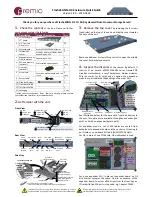
Introduction
1.3 Decommissioning and Disposal
Failsafe Alarm Relay
Latches to default state when a power disruption or other alarm
condition occurs. For more information, refer to:
•
"Connecting the Failsafe Alarm Relay (Page 15)"
•
"Failsafe Alarm Relay Specifications (Page 21)"
Power Supply Terminal Block
A pluggable terminal block. For more information, refer to:
•
•
"Power Supply Specifications (Page 21)"
Chassis Ground Terminal
Protects the device from power surges and accumulated static
electricity. For information about grounding the device, refer to
1.3
Decommissioning and Disposal
Proper decommissioning and disposal of this device is important to prevent malicious
users from obtaining proprietary information and to protect the environment.
Decommissioning
This device may include sensitive, proprietary data. Before taking the device out of
service, either permanently or for maintenance by a third-party, make sure it has
been fully decommissioned.
For more information, refer to the associated
Configuration Manual
.
Recycling and Disposal
For environmentally friendly recycling and disposal of this device and related
accessories, contact a facility certified to dispose of waste electrical and electronic
equipment. Recycling and disposal must be done in accordance with local
regulations.
1.4
Cabling Recommendations
All copper Ethernet ports on RUGGEDCOM products include transient suppression
circuitry to protect against damage from electrical transients and conform with
IEC 61850-3 and IEEE 1613 Class 1 standards. This means that during a transient
electrical event, communications errors or interruptions may occur, but recovery is
automatic.
Siemens also does not recommend using copper Ethernet ports to interface with
devices in the field across distances that could produce high levels of ground
potential rise (i.e. greater than 2500 V), during line-to-ground fault conditions.
4
RUGGEDCOM RS1600
Installation Manual, 01/2021, C79000-G8976-1013-03














































